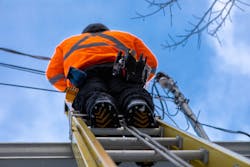Clarification: An earlier version of this article stated the BLS does not mention BICSI or its professional credentials in its coverage of the Telecommunications Technician job category. In fact, the Department of Labor for years has listed several BICSI credentials on its careeronestop.org website, which the Department describes as "your source for career exploration, training and jobs."
After years of consideration and research, the United States Department of Labor’s Bureau of Labor Statistics now recognizes telecommunications technicians as a standalone job category, separate from electrical line workers. In October, the BLS reported compensation and job-outlook information for this job category for the first time. In its report, the BLS stated in 2022, the median pay for telecommunications technicians in the United States is $60,190 per year.
Wide wage range for telecom technicians
“The median wage is the wage at which half the workers in an occupation earned more than that amount and half earned less,” the Bureau explained. “The lowest 10% earned less than $37,060, and the highest 10% earned more than $93,300,” it added.
The BLS divides the job category into three segments: telecommunications line installers and repairers; telecommunications equipment installers and repairers, except line installers; and radio, cellular, and tower equipment installers and repairers.
Part of the BLS’s reporting on the job category is the outlook for that job. For telecommunications technicians, the Bureau says overall employment “is projected to grow 6% from 2022 to 2032, faster than average for all occupations. About 31,500 openings for telecommunications technicians are projected each year, on average, over the decade. Many of those openings are expected to result from the need to replace workers who transfer to different occupations or exit the labor force, such as to retire.” The BLS added that the construction of new infrastructure systems will contribute to the employment growth.
The BLS report also includes employment and wage statistics for different states and geographic regions of the country, which can be found here.
Challenging work conditions
As it does with other job categories, the BLS describes telecom technicians’ job duties and work environments, as well as how to enter the field. The description of a technician’s work environment will sound familiar to experienced professionals who have spent time “in the trenches.” The BLS says the technician’s job “may require them to climb onto rooftops; into attics; and up ladders, telephone poles, and communications towers. They occasionally work in cramped spaces and in awkward positions, including stooping, crouching, or crawling. Other times they must reach high or lift and move heavy equipment and parts.”
The description of how to become a telecommunications technician relates most strongly to those working in outside-plant environments. When detailing licensing, certification, and registration opportunities, the BLS says, “Manufacturer or employer-provided certification may be helpful for some telecom technicians. For example, the Society of Cable Telecommunications Engineers offers the Broadband Telecom Center Specialists (BTCS) certification, and the Fiber Optic Association offers multiple certifications for telecommunications line installers and repairers.”
The BLS is part of the U.S. Department of Labor. On its careeronestop website, the Department recognizes several of BICSI's professional credentials. The Deparment of Labor describes the careeronestop website as "your source for career exploration, training and jobs."
The BLS Telecommunications Technician report continues, “Training length and topics vary by position and employer. For example, central office technicians typically receive electrical training. Telecommunications line installers and repairers who work for telecommunications companies may benefit from additional training provided by equipment manufacturers, schools, unions, or industry organizations. Radio, cellular, and tower equipment installers and repairers typically learn subjects such as tower climbing and rescue, electrical skills and concepts, and radio frequency fundamentals.”
